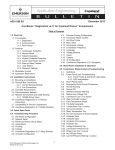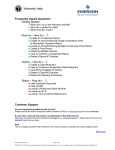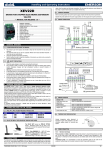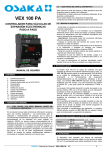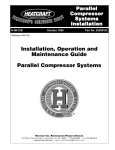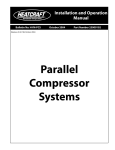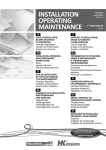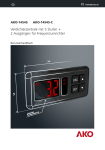Download Emerson AE4-1287 R7 System information
Transcript
AE4-1287 R8
AE4-1287 R8
March 2015
Copeland Discus™ Compressors with Demand Cooling™ System
TABLE OF CONTENTS
Section
Page
Section
Safety
Figures and Tables
Safety Instructions ...................................................2
Safety Icon Explanation ...........................................2
Instructions Pertaining to Risk of Electrical
Shock, Fire, or Injury to Persons ...........................3
Safety Statements ...................................................3
Demand Cooling System .........................................7
Low Temperature Operating Envelopes With and
Without Demand Cooling....................................8
CoreSense™ Discharge Temperature Protection....8
Standard Location of CoreSense
Temperature Probe ............................................9
Low Temperature Operating Envelope for R-22 at
65°F Return Gas (with Head Fan) ...................9
Demand Cooling System Diagram ........................10
Demand Cooling Wiring Schematics ................11-13
Demand Cooling Operating Setpoints and
Control Actions ....................................................14
Demand Cooling Kit Part Numbers .......................14
Introduction...............................................................4
Updated Discharge Temperature Guidelines ...........4
Operating Range .....................................................4
Demand Cooling System .........................................4
Demand Cooling System Design.............................5
Demand Cooling Compressors ...............................5
Condenser Sizing ....................................................5
Demand Cooling System Components ...................5
Demand Cooling with CoreSense™ Protection ........6
System Information ..................................................6
Demand Cooling with Discus™ Compressor
Unloading ..............................................................6
4D and 6D Unloading with Demand Cooling ...........7
3D Copeland Discus Digital™ compressors with
Demand Cooling ...................................................7
Performance Adjustment Factors ............................7
Demand Cooling Specifications...............................7
© 2015 Emerson Climate Technologies, Inc.
Page
Appendix - Demand Cooling Diagnostics ...... 15-18
1
AE4-1287 R8
Safety Instructions
Copeland Discus™ compressors are manufactured according to the latest U.S. and European Safety Standards.
Particular emphasis has been placed on the user's safety. Safey icons are explained below and safety instructions
applicable to the products in this bulletin are grouped on page 3. These instructions should be retained throughout
the lifetime of the compressor. You are strongly advised to follow these safety instructions.
Safety Icon Explanation
DANGER
DANGER indicates a hazardous situation which, if not avoided, will result
in death or serious injury.
WARNING
WARNING indicates a hazardous situation which, if not avoided, could
result in death or serious injury.
CAUTION
CAUTION, used with the safety alert symbol, indicates a hazardous
situation which, if not avoided, could result in minor or moderate injury.
NOTICE
CAUTION
© 2015 Emerson Climate Technologies, Inc.
NOTICE is used to address practices not related to personal injury.
CAUTION, without the safety alert symbol, is used to address practices
not related to personal injury.
2
AE4-1287 R8
Instructions Pertaining to Risk of Electrical Shock, Fire, or Injury to Persons
WARNING
WARNING
WARNING
CAUTION
ELECTRICAL SHOCK HAZARD
• Disconnect and lock out power before servicing.
• Discharge all capacitors before servicing.
• Use compressor with grounded system only.
• Molded electrical plug must be used when required.
• Refer to original equipment wiring diagrams.
•
• Failure to follow these warnings could result in serious personal injury.
PRESSURIZED SYSTEM HAZARD
• System contains refrigerant and oil under pressure.
• Remove refrigerant from both the high and low compressor side before
removing compressor.
•
• Never install a system and leave it unattended when it has no charge,
a holding charge, or with the service valves closed without electrically
locking out the system.
• Use only approved refrigerants and refrigeration oils.
• Personal safety equipment must be used.
• Failure to follow these warnings could result in serious personal injury.
BURN HAZARD
• Do not touch the compressor until it has cooled down.
• Ensure that materials and wiring do not touch high temperature areas of
the compressor.
• Use caution when brazing system components.
• Personal safety equipment must be used.
• Failure to follow these warnings could result in serious personal injury or
property damage.
COMPRESSOR HANDLING
• Use the appropriate lifting devices to move compressors.
• Personal safety equipment must be used.
• Failure to follow these warnings could result in personal injury or
property damage.
Safety Statements
• Refrigerant compressors must be employed only for their intended use.
•
install, commission and maintain this equipment.
•
• All valid standards and codes for installing, servicing, and maintaining electrical and
refrigeration equipment must be observed.
© 2015 Emerson Climate Technologies, Inc.
3
AE4-1287 R8
Introduction
than AHRI rating condition at 65°F return gas.
Energy efficiency regulations drive continuous change
in the availability of refrigerants to the marketplace. With
the introduction of R-22 as a replacement for R-502,
compressors began to experience internal discharge
temperatures that exceed the safe operational limits for
long term stability of refrigerant oil. In response to this,
Demand Cooling was developed as a reliable method
to keep discharge temperatures reduced to a safe level
without inhibiting the operating limits of the compressor.
With the phase out of R-22, the following refrigerants
have become viable alternatives for R-22 applications:
R-407A, R-407C, R-407F, R-448A, R-449A. All of the
above mentioned refrigerants require special attention
to discharge temperature control.
3. Since February 2011, Copeland Discus
compressors come standard with more
comprehensive compressor protection via
CoreSense™ technology
Due to these factors, Emerson is pleased to offer
updated operating envelopes and guidelines for
low temperature R-407A/C/F and R-448A/R-449A
applications. For details on specific applications with
Demand Cooling and without Demand Cooling, refer
to page 8 of this bulletin.
Operating Range
Demand Cooling is designed to protect the
compressor from high discharge temperatures over
the evaporating and condensing temperature ranges
shown in Figures 2, 3, and 6. Additionally, in instances
where compressor return gas temperature and
condensing temperature is closely controlled, the
envelope in Figure 2 is achievable without the addition
of Demand Cooling components to the compressor.
CAUTION
POE must be handled carefully and the proper
protective equipment (gloves, eye protection, etc.)
must be used when handling POE lubricant. POE
must not come into contact with any surface or
material that might be harmed by POE, including
without limitation, certain polymers (e.g. PVC/CPVC
and polycarbonate).
Demand Cooling System
Demand Cooling is compatible with single (conventional)
units as well as parallel racks.
Updated Discharge Temperature Guidelines
Emerson Climate Technologies developed and
released the Demand Cooling™ system for Copeland
Discus™ compressors to provide a solution for
applications with high discharge temperatures
such as the R-22 low temperature refrigeration
applications. Without Demand Cooling, these high
temperatures typically resulted in overheating of the
lubricant leading to compressor failures.
The Demand Cooling module uses the signal of
a discharge head temperature sensor to monitor
discharge gas temperature. If a critical temperature
is reached, the module energizes a long life injection
valve which meters a controlled amount of saturated
refrigerant into the compressor suction cavity to cool
the suction gas. This process controls the discharge
temperature to a safe level. If, for some reason, the
discharge temperature rises above a preset maximum
level, the Demand Cooling module will turn the
compressor off (requiring a manual reset) and actuate
its alarm contact. To minimize the amount of refrigerant
which must be injected, the suction gas cooling
process is performed after the gas has passed around
and through the motor.
Since additional refrigerant solutions such as R-407A,
R-407C, R-407F, R-448A, and R-449A became
available to the marketplace, there have been
numerous requests to operate Discus compressors
without Demand Cooling in applications where it is
possible to control both condensing temperature and
the return gas temperature to low enough levels to
avoid overheating related failures. Emerson Climate
has re-evaluated operating guidelines for these
refrigerants for the following reasons:
Injection valve orifices have been carefully chosen
for each body style to be large enough to provide the
necessary cooling when required but not so large
that dangerous amounts of liquid are injected, or that
excessive system pressure fluctuation occurs during
injection valve cycling. Normally, pressure fluctuations
are no greater than 1 to 2 psi. It is important to
use the correct valve for each compressor body style.
1. R-407A/C/F, R-448A/R-449A discharge
temperatures are higher than R-404A, but lower
than R-22.
2. Many new refrigeration systems operate at lower
compressor superheat/return gas temperatures
© 2015 Emerson Climate Technologies, Inc.
4
AE4-1287 R8
Performance data for Demand Cooling compressors
includes the effects of injection when it is
required. The approximate conditions where injection
occurs are shown in Figures 2, 3, and 6. At the conditions
where Demand Cooling is operating, the performance
values are time averages of the instantaneous values,
since small fluctuations in suction and discharge
conditions occur as the Demand Cooling injection
valve cycles.
temperature Discus CFC-502 compressors have been
modified for use with R-22, R-407 A/C/F, or R-448A/449A
and Demand Cooling. The modifications are the addition
of an injection port on the compressor body and a
temperature sensor port in the head of the compressor.
The locations of these ports are critical and were
determined through an extensive development program.
The R-22, R-407 A/C/F, or R-448A/449A rating data
includes the effects of Demand Cooling injection when
operating conditions require it based on 65 °F return
gas.
Demand Cooling System Design
When Demand Cooling operates, it 'diverts'
refrigeration capacity in the form of injected saturated
refrigerant from the evaporator to the compressor
(See Figure 7 for a typical single system schematic).
The effect of this diversion on evaporator capacity
is minimal because the diverted capacity is used to
cool the gas entering the compressor. As the gas is
cooled, it naturally becomes more dense, increasing
the mass flow through the compressor, which partly
compensates for the capacity diverted from the
evaporator.
Condenser Sizing
Condensers should be sized using conventional
methods. Demand Cooling has virtually no effect on
system heat of rejection.
Demand Cooling System Components
The Demand Cooling System (see Figure 1) consists
of: The Demand Cooling Temperature Sensor (TS),
The Demand Cooling Module (CM), and the Injection
Valve (lV).
If there is substantial heat gain along the suction
line, injection may result in a substantial loss in
evaporator capacity during Demand Cooling operation.
In order to minimize this loss, good practice indicates
Demand Cooling operation be kept to a minimum
through proper system design and installation practices.
There are three areas which can be addressed to
minimize the impact of Demand Cooling operation on
performance.
The TS uses a precision Negative Temperature
Coefficient (NTC) Thermistor (thermistor resistance
drops on temperature rise) to provide temperature
signals to the CM.
The IV meters refrigerant flow from the liquid line
to the compressor. The IV solenoid receives on-off
signals from the CM. When compressor cooling is
required the solenoid is energized and opens the IV
orifice to deliver saturated refrigerant to the compressor
for cooling. The valve orifice is carefully sized to
meet the requirements of each body style of Discus
compressors.
1. Compressor Return Gas Temperature: Suction lines
should be well insulated to reduce suction line heat
gain. Return gas superheat should be as low as
possible consistent with safe compressor operation.
The CM has three functional groups:
2. Condensing Temperatures: It is important when
using R22, R-407 A/C/F, or R448A/449A as a
low temperature refrigerant that condensing
temperatures be minimized to reduce compression
ratios and compressor discharge temperature.
A. The Input signal and calculator circuits
compare the temperature sensor input signal to an
internal set-point and decide whether to energize
the IV solenoid or, in the case of a problem, the
CM alarm relay.
3. Suction pressure: Evaporator design and system
control settings should provide the maximum
suction pressure consistent with the application
in order to have as low a compression ratio as
possible.
B. The output signal to the IV is controlled by
an electronic switch connected to the IV
solenoid so that, when required, refrigerant
vapor can be metered to the compressor to
prevent compressor overheating. One side of
the electronic switch is connected internally to
'L1' and the other side to output terminal 'S' (see
Figure 6).
Demand Cooling Compressors
No new compressor models have been introduced
for Demand Cooling. Instead, existing low
© 2015 Emerson Climate Technologies, Inc.
5
AE4-1287 R8
C. The alarm signal for local or remote control.
The alarm relay is energized, after a one minute
delay, by a continuous, low or high TS temperature
signal. An alarm signal can indicate the following:
communicated to the CoreSense Protection module.
See Figure 8E.
System Information
1. Demand Cooling is designed to work on all
Copeland Discus compressors equipped with
injection ports. A different kit is required for each
compressor body style and control voltage. See
Table 2 for a listing of Demand Cooling Kit part
numbers.
1. Compressor discharge temperature has
risen above the level designed to be
controlled by Demand Cooling.
2. A shorted sensor.
3. An open sensor.
In order to avoid nuisance trips, a one minute
time delay is provided before alarm after a continuous
high or low resistance reading or over temperature
condition.
2. The system must be clean. A dirty system may
have foreign material that can lodge in the solenoid
orifice. Always install a liquid line filter dryer in
the injection valve inlet line capable of removing
particles as small as 25 microns.
The alarm relay uses a single-pole-double-throw
contact. The contact terminals are 'L', 'M', and
'A':
3. Do not use any filters containing materials that
can leave the filter and possibly clog the IV orifice.
'L' - Common (to 'A' and 'M')
'L - A' - Normally Open (alarm signal, close on
alarm)
4. The liquid refrigerant supply line must be a
minimum of 3/8" and routed so it will not interfere
with compressor maintenance. Liquid refrigerant
must have sufficient subcooling at the injection
valve to prevent flashing upstream of the valve.
The Normally Closed (NC) contact of the alarm
relay ('L' to 'M') should be wired in the compressor
contactor control circuit so that opening this
contact removes the compressor from the line and
removes power to the CM. See Figures 5A, B, C, and D.
5. The liquid refrigerant supply line to the IV must be
supported so that it does not place stress on the
IV and IV tubing or permit excess vibration. Failure
to make this provision may result in damage to the
IV and its tubing and/or refrigerant loss.
Figures 5A and B also show a current sensing
relay (which must be used with compressors
employing internal over current protection.
The current sensing relay is already included
when using CoreSense protection) and Sentronic
oil pressure switch. The control circuit is purposely
arranged so that an internal overload protector trip
removes power to both the Sentronic™ and the Demand
Cooling module. This precaution prevents the oil
pressure switch from timing out and the Demand
Cooling solenoid from injecting when the compressor
is not operating.
6. A head fan must be used to help lower compressor
discharge temperatures for compressors using
HCFC-22. Return gas temperatures must NOT
exceed 65°F.
'L - M' - Normally Closed (compressor run. open
on alarm)
7. System designers are advised to review their
defrost schemes to avoid floodback to the
compressor which may occur at defrost termination
with R-22, R-407 A/C/F, or R-448A/449A. These
refrigerants have a significantly higher heat of
vaporization than does CFC-502, and if the same
design parameters used with CFC-502 are used,
floodback may occur.
The alarm relay requires a manual reset in order to call
attention to a system problem.
Demand Cooling with Discus Compressor Unloading
Demand Cooling with CoreSense Protection
Demand Cooling has been approved with unloading
for 4D, 6D and 3D Copeland Discus Digital™. Demand
Cooling has NOT been approved for 3D Moduload.
CoreSense Protection is compatible with Copeland™
Demand Cooling. However, the discharge temperature
protection is provided by the Demand Cooling
module. Discharge temperature information will not be
© 2015 Emerson Climate Technologies, Inc.
Note: For Discus compressors with CoreSense
Diagnostics with the build of material (BOM)
6
AE4-1287 R8
Performance Adjustment Factors
nomenclature beginning with -ADx (e.g. 4DKNF63KLTSK-AD0) Demand Cooling capability is built in.
Performance values for R-407A, R-407C, R-407F,
R-448A and R-449A are not provided in this bulletin. For
actual performance values refer to Product Selection
Software (PSS) or the Online Product Information (OPI)
at EmersonClimate.com.
4D and 6D Unloading with Demand Cooling
Demand Cooling protection is applicable with
compressors using conventional blocked suction
unloading. Earlier application guidelines required
that liquid injection only occur when the compressor
is in its fully loaded state. This was to avoid flooding
the compressor with saturated liquid. After further
evaluation, Emerson engineering has determined
that the Copeland Discus compressor will still flash
the injected liquid refrigerant when the compressor is
unloaded should the discharge temperatures govern
the need for added cooling. The Demand Cooling
module will only inject liquid when required. When the
temperature decreases to an acceptable level, the
module will stop injecting.
Since compressor discharge temperature depends
strongly on the return gas temperature, the amount
of injection and its effect on evaporator capacity and
mass flow will vary somewhat with return gas
temperature. The approximate effects of compressor
return gas temperature on evaporator capacity and
mass flow are calculated in the current version of
Copeland Product Selection Software (PSS).
Demand Cooling Specifications
Demand Cooling is designed to operate and
protect the compressor within the evaporating and
condensing envelope identified in Figure 2. Operating
setpoints and control actions are listed in Table 1.
3D Copeland Discus Digital with Demand Cooling
Demand Cooling can be used with 3D Copeland
Discus Digital compressors without adding extra
unloader control circuitry. The Demand Cooling
temperature sensing probe must be installed to replace
the temperature sensing probe that is provided with
the Digital Compressor Controller (IDCM). The T1 to
T2 connection on the Digital Compressor Controller
should be jumpered with a 5 kOhm 1 Watt resistor.
This allows the Demand Cooling module to protect
against high discharge temperatures and inject liquid
when needed.
Attached is the Demand Cooling Diagnostic
Troubleshooting Guide (Form No. 92-91)
See also:
Demand Cooling Installation Instruction Guides
Emerson Climate Technologies Publication Nos.
90-130 for 2D/3D Compressors
90-131 for 4D Compressors
90-133 for 6D Compressors
Figure 1 – Demand Cooling System
© 2015 Emerson Climate Technologies, Inc.
7
AE4-1287 R8
Without Demand Cooling
With Demand Cooling
- Head fan required
- CoreSense discharge temp protection required
- Head fan optional
Figure 2 – Low Temp Envelope without
Demand Cooling
Figure 3 – Low Temp Envelope with
Demand Cooling
Injection lines represent maximum operation point within discharge temperature limits of the compressor. For operating points
below the line, Demand Cooling would not be active. For instance at -25°F evaporating temperature and 80°F condensing and
65°F return gas there would not be injection. However at the same evaporating temperature and return gas temperature with
120°F condensing temperature there would be injection.
If Demand Cooling is not applied, CoreSense discharge temperature protection is required in addition to a head fan. Refer
to Figure 5 for CoreSense temperature probe installation location. For more information on CoreSense, See AE8-1367. If
Demand Cooling is applied, head fan and CoreSense are not needed.
Figure 4 – CoreSense Discharge Temperature Protection
(See AE8-1367 for additional instructions)
© 2015 Emerson Climate Technologies, Inc.
8
AE4-1287 R8
Figure 5 – Standard Location of CoreSense Temperature Probe
(for compressors without CoreSense Diagnostics)
R-22 Low Temp Applications
140
130
Demand Cooling
Required*
120
Condensing Te
emperature (°F)
110
100
90
65°F Return Gas Demand
Cooling Injecon Line
80
70
*If Liquid Injecon Is Not Installed, Recommend 265°F MAX Discharge Line Temp. Limit
60
50
40
30
-45
-40
-35
-30
-25
-20
-15
-10
-5
0
5
Evaporang Temperature (°F)
Figure 6 – Low Temperature Operating Envelope for R-22 at 65°F Return Gas (with Head Fan)
© 2015 Emerson Climate Technologies, Inc.
9
AE4-1287 R8
M
TO CONTROL
CIRCUIT
L
A
DEMAND-COOLING
CONTROL
S
MODULE
INJECTION VALVE
ELECTRICAL
CONTROL LINE
REFRIGERANT INJECTION LINE
MANUAL SHUTOFF
VALVE
DEMAND COOLING
SENSOR AND
SENSOR LINES
CONDENSER
INJECTION
LINE FILTER
RECEIVER
LIQUID LINE
FILTER DRIER
COMPRESSOR
INJECTION
SOLENOID
VALVE
SUCTION
LINE FILTER
TXV
EVAPORATOR
ACCUMULATOR
Figure 7
Demand Cooling System Diagram
© 2015 Emerson Climate Technologies, Inc.
10
SIGHT GLASS
AE4-1287 R8
Current
Sensing (CS)
Relay
240vac
Compressor
Contactor (CC)
Compressor
Motor
L1
L2
L3
Sentronic
NOTE: Compressors with
internal overload protection
MUST have some means,
such as a current sensing
relay, to deenergize the
Demand Cooling Module
and the Sentronic when the
compressor is not running!
Demand
Cooling
Module
L M
A
S
Control
Temp.
Sensor
240
2
M
L
A
Injection
Solenoid
Electronic
Switch
L1
CC
CS
L2
Figure 8A
Demand Cooling Wiring Schematic with Sentronic Oil Pressure Control and Current Sensing Relay
240vac
Current
Sensing (CS)
Relay
Compressor
Contactor (CC)
Compressor
Motor
L1
L2
L3
Demand
Cooling
Module
NOTE: The control circuit
must be arranged so that the
Demand Cooling Module
and the Sentronic are
deenergized when the
compressor is not running!
Controls
Temp.
Sensor
L M
A
S
Electronic
Switch
CC
Injection
Solenoid
CS
L1 L2
Figure 8B
Demand Cooling Wiring Schematic less Sentronic Oil Pressure Control
© 2015 Emerson Climate Technologies, Inc.
11
AE4-1287 R8
Compressor
Contactor (CC)
240vac
Compressor
Motor
L1
L2
L3
Sentronic
Demand
Cooling
Module
Controls
NOTE: The control circuit
must be arranged so that the
Demand Cooling Module
and the Sentronic are
deenergized when the
compressor is not running!
L M
A
S
Temp.
Sensor
240
2
L M
CC
A
Injection
Solenoid
Electronic
Switch
L2
L1
Figure 8C
Demand Cooling Wiring Schematic with Sentronic Oil Pressure Control less Current Sensing Relay
L2
L1
Injection
Solenoid
Temp.
Sensor
S
Electronic
Switch
Controls
L2
L1
NOTE: The control circuit
must be arranged so that the
Demand Cooling Module
and the Sentronic are
deenergized when the
compressor is not running!
240
2
Demand
Cooling
Module
L M
A
Sentronic
Oil Pressure
Control
M
L
A
Figure 8D
Demand Cooling Wiring Schematic with Isolated Control Contacts
© 2015 Emerson Climate Technologies, Inc.
12
AE4-1287 R8
NOTE: The CoreSense module is dual rated for 120v / 240v.
The Demand Cooling module must be matched to the line voltage.
L1
* 120v or
240v
L2
CoreSense
Module Terminal
Strip
Demand
Cooling Module
L
120v
240v
L
M
Current Sensor Connector
2
M
CC
A
Control
Temp.
Sensor
Current
Sensor
A
S
Injector Control
Switch
Injection
Solenoid
L1
Contactor
L2
Figure 8E
Coresense Protection with Copeland Demand Cooling
© 2015 Emerson Climate Technologies, Inc.
13
AE4-1287 R8
Table 1
Demand Cooling Operating Setpoints and Control Actions
Table 2
Demand Cooling Kit Part Numbers
Frequency
50HZ
60HZ
Voltage
2D
3D
4D
6D
4D*X,4D*N¹
6D*X,6D*N¹
120V
998-1000-12
998-1001-13
998-1001-14
998-1001-16
998-2001-14
998-2001-16
240V
998-1000-22
998-1001-23
998-1001-24
998-1001-26
998-2001-24
998-2001-26
120V
998-1000-12
998-1000-13
998-1000-14
998-1000-16
998-2000-14
998-2000-16
240V
998-1000-22
998-1000-23
998-1000-24
998-1000-26
998-2000-24
998-2000-26
Demand Cooling Kits Include:
Demand Cooling Module with 2 Mounting Screws
Temperature Sensor with 3ft. Shielded cable
Injection Valve and Solenoid (without mounting hardware)
Installation/Troubleshooting Guide
Optional Demand Cooling Module Mounting Brackets
2D and 3D Models
4D and 6D Models
998-0700-09
998-0700-10
3ft. Shielded Cable (Standard)
10ft. Shielded Cable (Optional)
085-109-00
085-109-01
Temperature Sensors
¹4D*X, 4D*N, 6D*X, 6D*N Indicate Discus III Models
The contents of this publication are presented for informational purposes only and are not to be construed as warranties or guarantees, express or implied,
regarding the products or services described herein or their use or applicability. Emerson Climate Technologies, Inc. and/or its affiliates (collectively "Emerson"),
as applicable, reserve the right to modify the design or specifications of such products at any time without notice. Emerson does not assume responsibility for the
selection, use or maintenance of any product. Responsibility for proper selection, use and maintenance of any Emerson product remains solely with the purchaser
or end user.
© 2015 Emerson Climate Technologies, Inc.
14
AE4-1287 R8
Appendix
®
Copeland Demand Cooling® Diagnostics
Demand Cooling Operating Characteristics
2. Place the wrapped probe-sensor inside an
insulation shield to protect it from air currents. Use
a material such as Permagum® or piping insulation
such as ArmafleX®. The insulating material should
be tightly wrapped around the taped-sensor and
the wrap should be secured with wire or tiewraps if
necessary. There should be no free air movement
over the metal part of the taped-sensor.
The Copeland Demand Cooling control uses a
Negative Temperature Coefficient thermistor (NTC).
Incorporated in the Demand Cooling temperature sensor
(hereafter called 'sensor'), is a compressor discharge
temperature monitor. When the temperature sensed
by the NTC Thermistor rises, its resistance falls, and
when temperature sensed by the thermistor drops, its
resistance increases.
3. Connect the digital ohmmeter to the two pins on
the plug of the sensor. Make sure there is a good
connection. Do not take a sensor resistance
measurement until there is no change in the
ohmmeter display.
The sensor resistance signal is coupled to the Demand
Cooling module (hereafter called 'module'). The module
uses the signal to determine when the compressor
discharge temperature has risen to a point where
Demand Cooling is required. When Demand Cooling
is required the module energizes the Demand Cooling
Injection Valve (hereafter called 'injection valve') and
the injection valve injects saturated refrigerant into
the compressor suction cavity until the discharge
temperature drops to an acceptable level.
4. Measure the temperature of the thermometer
sensor and find the corresponding calculated
sensor resistance value from Table 1. Since the
values of Table 1 are not continuous, you may
have to interpolate.
5. The sensor resistance reading should be within
+/- 5% of the calculated resistance value of Step 4.
Whenever the compressor starts and the module first
receives power, there is a one minute delay during
which the Demand Cooling system injects saturated
refrigerant if it is required, but waits for compressor
discharge temperature to stabilize before checking for
alarm conditions. After one minute, if the resistance of
the probe is too low (the resistance equivalent of 310°F),
or too high (the resistance equivalent of 4°F) the module
will trip and deenergize the compressor.
End of Test
Appendix Table 1
Thermometer
Temp. (F°)
Calculated
Sensor
Resistance
(Ohms)
Thermometer
Temp. (F°)
Calculated
Sensor
Resistance
(Ohms)
59
141426
86
72504
60.8
135000
87.8
69480
Bench Testing Demand Cooling Components
62.6
128907
89.6
66609
Bench Check of the Sensor
64.4
123129
91.4
63864
Required Equipment:
66.2
117639
93.2
61254
68
112437
95
58770
69.8
107478
96.8
56394
71.6
102762
98.6
54126
73.4
98289
100.4
51966
75.2
94041
102.2
49914
• A digital thermometer of +/- 1 % full scale accuracy.
The thermometer probe should be checked for
calibration in an ice water bath or compared with
another accurately known temperature source.
• A digital ohmmeter capable of +/- 1 % accuracy. The
ohmmeter should be checked for accuracy with a
known resistance value such as a +1 % resistor.
Room temperature should be stable and between 60°F
and 110°F.
1. Wrap the end of the digital thermometer probe
and the metal end of the Demand Cooling sensor
probe together with electrical tape or hook and loop
fasteners (Velcro®). The end of the probe and the
end of the thermometer must touch.
© 2015 Emerson Climate Technologies, Inc.
15
77
90000
104
47943
78.8
86139
105.8
46053
80.6
82476
107.6
44262
82.4
78984
109.4
42543
84.2
75663
AE4-1287 R8
Bench Check of the Module and Injection Valve
•
A controlled voltage source the same as the rating
of the module and the injection valve.
•
A multimeter.
6. After one minute, the module should trip. The run
contact 'L' to 'M' should open, and the alarm contact
'L' to 'A' should close. Deenergize the module and
disconnect the injection valve. The resistance should
be zero ohms between 'L' and 'A', and between 'L'
and 'M' there should be an open circuit.
•
If the jumper supplied on the sensor plug of the
module is not available you may use a small paper
clip for the test.
7. Reset the module. Remove the jumper from the
module probe plug so there is an open circuit at
the plug input.
Required equipment:
8. Energize the module.
Before starting the test, make sure you have the correct
module and injection valve.
When the sensor connection to the Demand Cooling
Module is opened the very high resistance is
interpreted by the module as a very low temperature.
Consequently no injection signal is sent to the
injection valve.
1. With the module control voltage disconnected, short
the module sensor plug female terminals with the
jumper or the paperclip. Press the module reset
button.
9. The injection valve should be energized. A recheck
of Step 5 will confirm this.
2. Attach the injection valve leads to terminals 'L2'
and 'S' of the module. The injection valve should
be propped in an upright position.
10. Refer to the test of Step 6 to check the alarm circuit.
Reset the module after the test. If the module or
injection valve fails any of the checks it should be
replaced.
3. You should read zero ohms between the 'L' and 'M'
terminals of the module. This is the Normally Closed
(NC) contact of the Single Pole Double Throw (SPDT)
module alarm relay. You should read an open circuit
between 'L' and 'A'. This is Normally Open (NO)
contact of the alarm relay.
End of Test
Installed System Checks of
Demand Cooling Components
When the Demand Cooling control injects saturated
refrigerant into the suction cavity of the compressor,
the outlet tube of the injection valve frosts. If the
module sensor connection is opened or shorted while
the module is energized, the module will trip after one
minute of operation and must be reset to continue.
4. Energize the module by bringing module rated
voltage to terminals 'Ll' and 'L2'.
*When the sensor connection at the module is
shorted, a very low resistance is seen by the module
as a very high temperature, and an injection signal
is sent to the injection valve.
Before starting the test, make sure you have the
correct module and injection valve.
5. The injection valve will be energized by the closing
of an electronic switch in the module. The control
voltage to energize the injection valve may be
measured across module terminals 'S' and 'L2'.
If the Injection Valve is Not Injecting
1. With the system deenergized, disconnect the sensor
from the module and jumper the terminals of the
module connector. Energize the system so the
compressor is running and the module is activated.
The injection valve should begin injecting, and frost
should form on the outlet tube of the injection valve.
If frost forms, go to Step 4 otherwise continue to
Step 2.
*Because this measurement is made across an
electronic switch some 'leakage' voltage may be
measured when the switch is deenergized. This
voltage is much less than the control voltage which
is measured when the electronic switch is closed.
The injection valve operation may also be checked
by listening to the 'click' heard each time the coil
of the injection valve is energized and the injection
valve solenoid plunger seats itself.
2. If frost does not form in Step 1, check to see if there
is control voltage on the coil of the injection valve
(terminals 'L2' and 'S' of the module).
If background noise prevents an audible check
of the injection valve coil and magnant operation,
grip the injection valve magnet housing and loosen
its housing cover screw until magnet vibration is
felt. This proves solenoid operation. Retighten the
magnet housing cover screw after this check.
© 2015 Emerson Climate Technologies, Inc.
*Because this measurement is made across an
electronic switch in the module some 'leakage'
voltage may be measured when the switch is
deenergized. This voltage is much less than the
control voltage which is measured when the switch
16
AE4-1287 R8
is closed. If correct control voltage is not present,
replace the module.
2. Deenergize the system and disconnect the sensor
from the module. Energize the system so the
compressor is running. The frosting should stop.
3. If correct control voltage is present, make sure there
is a full sight glass of liquid from the receiver at the
injection valve. If there is not a full sight glass of
liquid, the piping from the receiver should be checked
before proceeding.
If Step 2 is successful, go to Step 4 otherwise
continue to Step 3.
3. If frosting does not stop, with the sensor
disconnected, deenergize the system. Disconnect
the voltage supply to the injection valve and restart
the compressor. If frosting does not stop, replace
the injection valve. If frosting stops, replace the
module.
Piping connections and sizes must be chosen to
assure a full sight glass of liquid for the injection
valve during any phase of the refrigeration system
operation. Piping that is too small, or connections
taken from the tops of manifolds rather from the
bottom may result in a lack of refrigerant available
for the injection valve just when it needs it most,
such as after a defrost.
4. If frosting stops when the sensor is disconnected,
check the system for high suction and/or condensing
temperatures before proceeding. As suction and/or
discharge temperatures rise toward the Demand
Cooling limits (40° F evaporator temperature, 130°F
condensing temperature), Demand Cooling will call
for injection for longer periods of time and may
appear to be continuously injecting. Use Figure 1
to check Demand Cooling operating areas. Figure
1 shows where injection begins for two return gas
temperatures (65°F and 20°F) for R-22. The arrows
marked (A) and (B) on the graph show the lowest
allowable evaporating temperatures using a given
condensing temperature.
If a full sight glass is present and frost still does not
form, replace the injection valve.
4. With the module sensor connector shorted or
open and the module and compressor running,
the module should trip in one minute and stop the
compressor.
If the compressor does not stop, check the control
circuit wiring to be sure the module is wired to stop
the compressor when the module trips. If the wiring
is correct, replace the module.
Point (A) shows that with 65°F return gas and 110°
F condensing temperature, the lowest evaporating
temperature without Demand Cooling injection
is -5°F. Point (B) shows that if the return gas
temperature can be lowered to -20°F, while still at a
condensing temperature of 110°F, the evaporating
temperature may be lowered to -20°F without
Demand Cooling operation.
5. Check the discharge temperature by performing
Steps 1-6 of the Injection Valve is Cycling On and
Off test.
If the discharge temperature is higher than the
allowable Table 2 selection, remove the sensor
from the compressor and use the Bench Check of
the Sensor Test to check the probe. Replace the
sensor if necessary.
Your injection point can be approximated by
drawing a line representing your return gas
temperature in between and parallel to the two
return gas temperatures on the Figure 1 (Area
2). The higher your return gas temperature is,
the closer it will be to the '65°F line'. The lower it
is, the closer it will be to the '20°F line'. You can
then draw your own dotted lines representing your
condensing and evaporating temperatures to see if
you are in the in a Demand Cooling injection zone.
End of Test
If the Injection Valve is Continually Injecting
1. Make sure there is a full sight glass of liquid from
the receiver. If there is not a full sight glass of liquid,
there may not be enough liquid to allow Demand
Cooling to cycle because it uses all available
liquid to keep the discharge temperature below
a dangerous level. The piping from the receiver
to the injection valve should be checked before
proceeding.
The higher your condensing temperatures are for a
given evaporating temperature, the more injection
is required until finally Demand Cooling may be
energized constantly.
Piping connections and sizes must be chosen to
assure a full sight glass of liquid for the injection
valve during any phase of the refrigeration system
operation. If the suction pressure rises then go to
Step 6.
© 2015 Emerson Climate Technologies, Inc.
If the suction and condensing temperatures are
lower than, or borderline to the injection areas of
Figure 1 then go to Step 5.
If they are much higher the system should be
corrected to lower the temperatures or there may
17
AE4-1287 R8
be occasional Demand Cooling trips. If lowering
system temperatures corrects the continuous
problem, the test is ended, if not go to Step 5.
1) Measure the room temperature.
2) Connect the temperature sensor probe to the
compressor discharge line 6” from the discharge
valve. The probe must be tightly secured to the
discharge line, and must be well insulated so that
moving air will not produce a false reading (a poorly
insulated probe may cause errors of more than
30°F!).
5. Deenergize the refrigeration system. Close the
suction service valve. Turn the system on and
pump down the compressor to 2-3 psig. Turn
the system off. Wait one minute. The pumpdown
should hold and the pressure should not rise.
If the suction pressure rises then go to Step 6.
If the suction pressure does not rise the sensor
is calling for injection when it is not required and
should be replaced.
3) Using Table 2, check the conditions that are closest
to your system. (The evaporator temperature used for
Table 2 was -25°F). There may be deviation from the
table due to system variation, however, within 5-10%
of the published discharge pressures is acceptable.
6. If the suction pressure rises, the suction service
valve may not be entirely closed, the valve plate
or valve plate gasket may have been damaged.
Damage to the valve plate or its gasket can cause
discharge gas to be introduced to the suction
cavity, resulting in an artificially high suction
temperature. The artificial suction temperature,
in turn, causes an earlier than required Demand
Cooling injection.
Note: Table 2 is for R-22. Emerson Climate
Technologies recommends assuming that R-407
A/C/F, R-448A, and R-449A run about 10°F to 15°F
cooler per the approved operating ranges.
4) When operating under published conditions, the
discharge temperature should never be more than
280°F or less than 200°F. If successful, the test is
ended. Otherwise continue to the next step.
Replace the compressor valve plate and gaskets
if required.
5) If the measured discharge temperature is lower by
more than 10% of the discharge temperature of Table
2, perform Steps 5-8 of the 'If The Injection Valve Is
Continually Injecting' test.
End of Test
If the Injection Valve is Cycling On and Off
If the measured discharge temperature is more than
280°F, replace the sensor.
When the saturated refrigerant is injected into the
compressor suction cavity it lowers the temperature
sensed by the sensor. The lower temperature in turn
causes the injection valve to shutoff. After shutoff the
temperature in the suction cavity rises again until it is high
enough for injection to start. The result of this cycling is
that frost on the injection valve outlet tubing alternately
appears during injection, and then disappears after
injection stops.
End of Test
Appendix Table 2
Compressor
Model
Room
Temp. (°F)
2D
3D
4D
6D
Condensing
Temp. (°F)
Discharge
Temp. (°F)
80
80
250-270
110
110
270-280
80
80
240-256
110
110
265-280
80
80
230-260
110
110
260-280
80
80
250-270
110
110
250-270
Appendix Figure 1
Demand Cooling Areas of Expected Injection
Form No. 92-91 R2 (4/09)
© 2015 Emerson Climate Technologies, Inc.
18


















